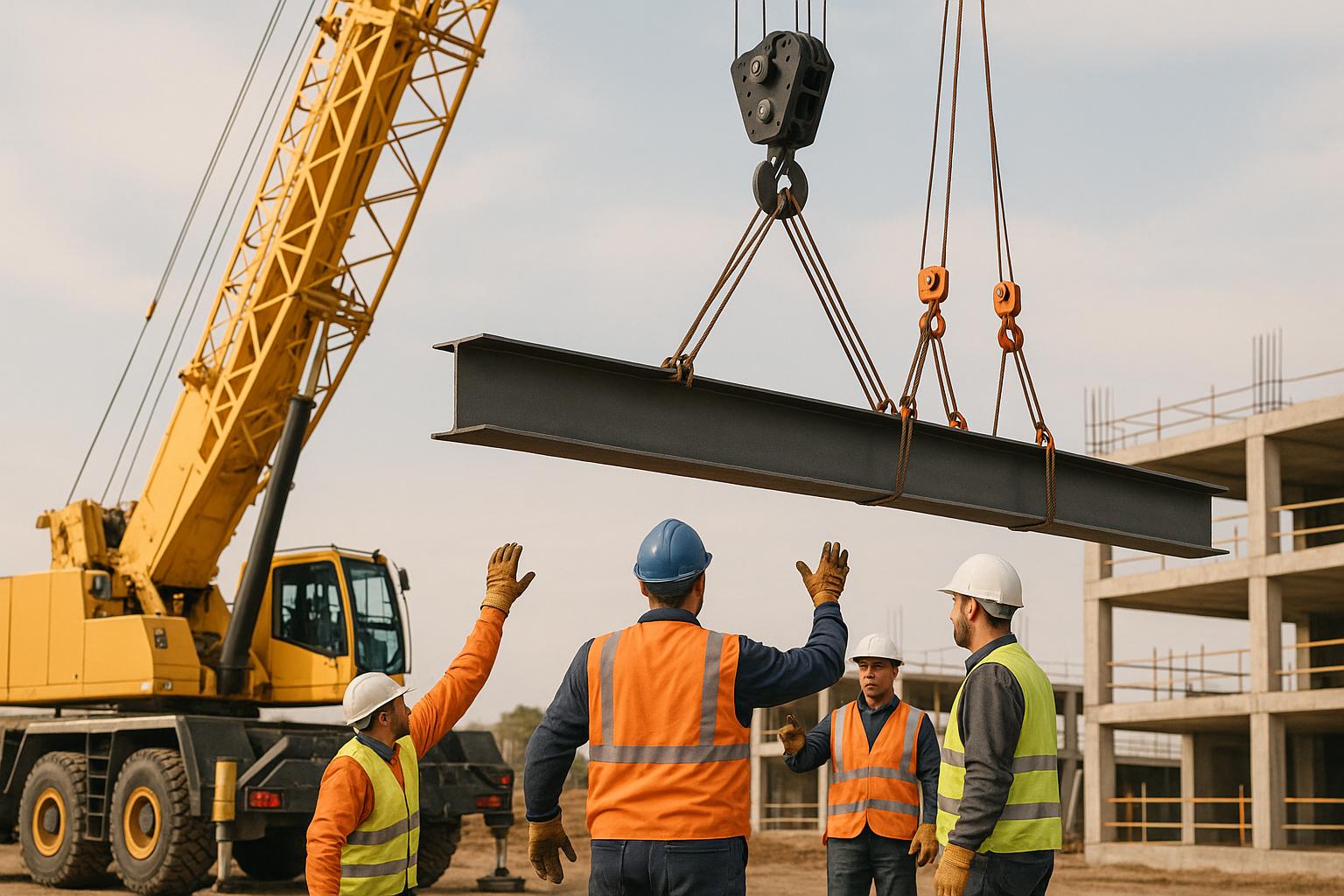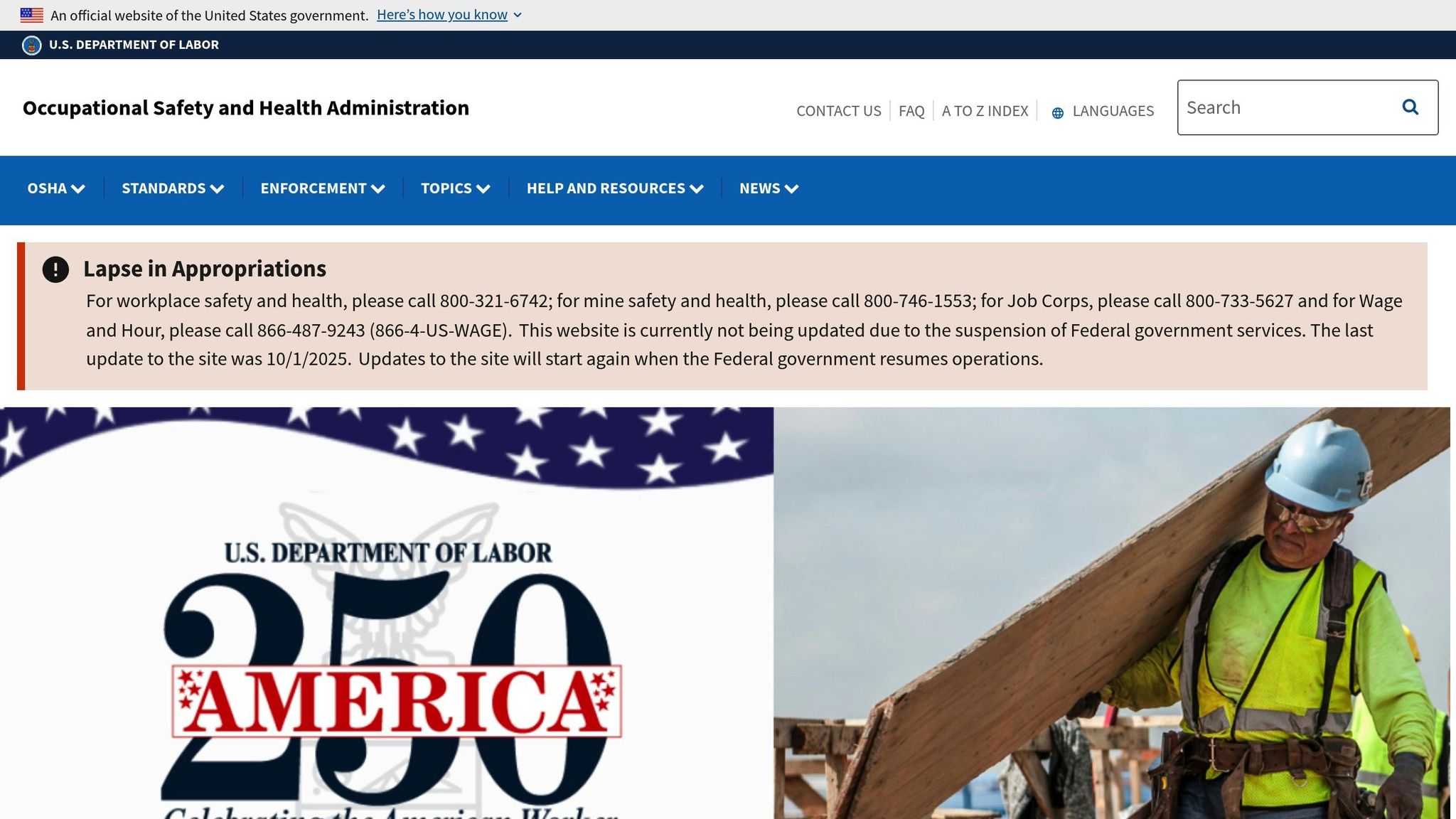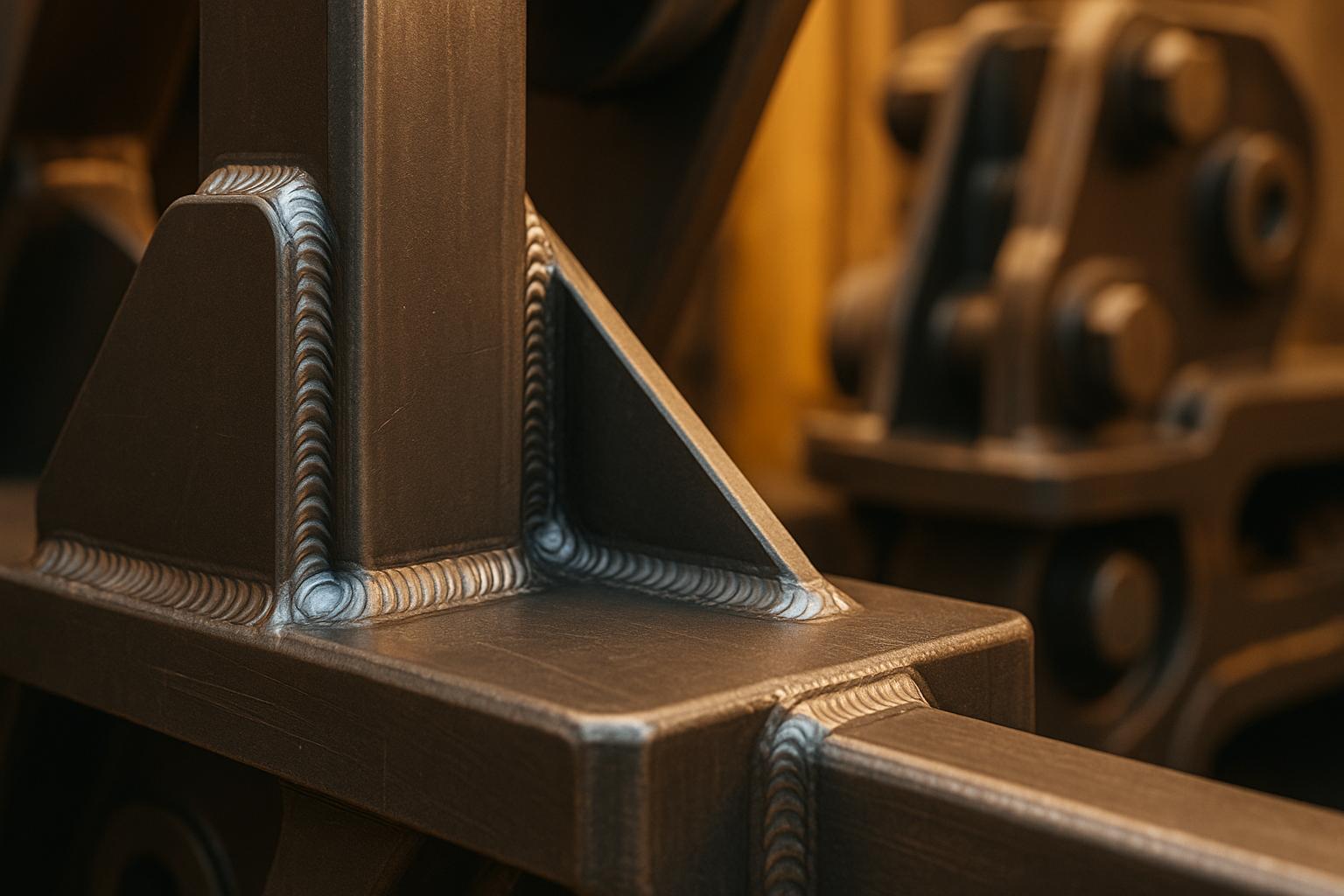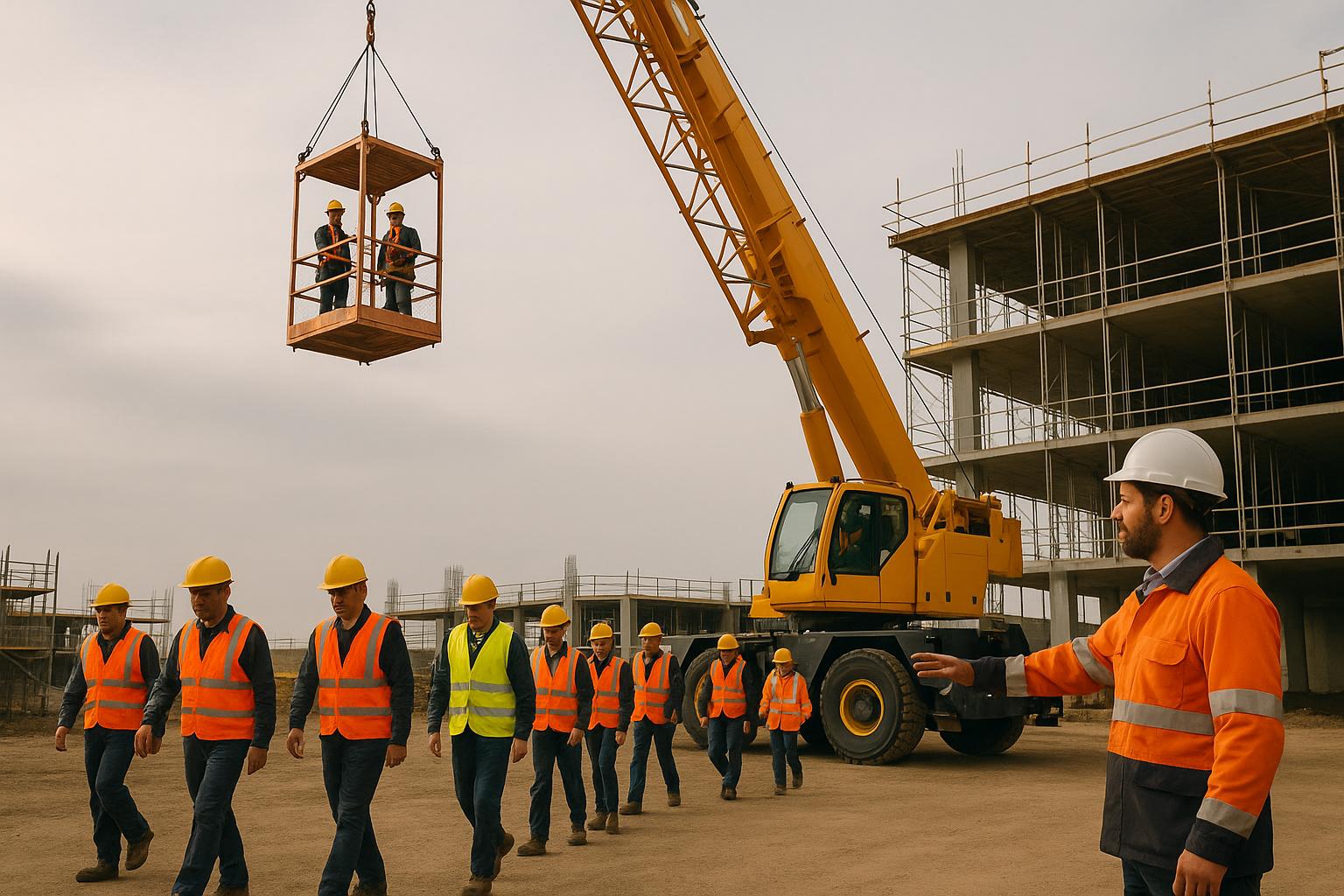Solving Common Crane Rigging Problems Fast

Crane rigging is critical for safely lifting and moving heavy loads on construction sites, but it comes with challenges like unknown load weights, gear failures, and weather risks. Quick problem-solving is key to avoiding delays, ensuring safety, and maintaining project timelines.
Key Solutions:
- Accurately Measure Load Weight: Use calibrated crane scales or load cells for precise results. Double-check manufacturer specs and account for rigging gear weight.
- Inspect Equipment Regularly: Perform daily checks on slings, shackles, and hooks. Maintain detailed records and replace worn items promptly.
- Choose the Right Tools: Match slings, hitches, and taglines to the load’s weight, shape, and stability needs. Use protective gear for sharp edges.
- Plan for Weather: Monitor wind, temperature, and conditions. Use tools like wind meters and protect equipment from extreme elements.
- Improve Communication: Train teams on hand signals and use reliable radios to coordinate operations.
By following OSHA and ASME standards, investing in the right tools, and training operators, you can tackle rigging challenges safely and efficiently. Whether it’s load monitoring or weather adjustments, preparation and precision are the keys to success.
Rigging & Sling Failures: Case Studies & Solutions - ITI
Common Crane Rigging Problems
One of the biggest challenges in crane rigging is dealing with unknown load weight, which can disrupt operations and compromise safety.
Unknown Load Weight
Relying on manufacturer specifications for load weight can sometimes lead to errors. These figures might be smudged, mistranslated, or outdated, making them unreliable. Estimating weight based on volume is also tricky, especially when dealing with complex shapes or materials of varying densities.
Another common oversight is forgetting to account for the weight of lifting gear - items like hook blocks, ropes, lifting beams, shackles, and slings. These can significantly add to the total load. Online calculators might seem helpful, but inaccurate inputs can create a false sense of security.
Environmental factors further complicate things. Muddy surfaces, sloped lifting points, or strong winds can introduce additional resistance, effectively increasing the load beyond its static weight. Tackling these inaccuracies is crucial for ensuring safer and smoother rigging operations.
Fast Solutions to Rigging Problems
When it comes to rigging, speed, safety, and efficiency are key. Using proven techniques can ensure your operations run smoothly without unnecessary risks.
How to Determine Load Weight Accurately
The most reliable way to determine load weight is through direct measurement using calibrated scales or load cells. Professional crane scales, for instance, can deliver accuracy levels between ±0.1% and ±0.5% of their capacity, making them an excellent choice for critical lifts.
"It is vitally important that the planner know the exact value of the load as it will be lifted." - Geoffrey H. Goldberg
Many rigging systems now feature crane scales that provide real-time load monitoring during lifts. This allows operators to track weight changes as the load moves. For industries requiring extreme precision, like aerospace or pharmaceuticals, high-accuracy scales can measure with better than ±0.05% accuracy for smaller loads.
If direct measurement isn't possible, estimating load weight based on volume can work - especially for materials with consistent density and regular shapes. By measuring the dimensions of the load, calculating its volume, and multiplying by the material's density, you can get a reasonable estimate. However, this method becomes less reliable for irregular shapes or mixed materials.
Another option is to consult manufacturer specifications found in technical drawings, shipping documents, or nameplates. While useful, these figures should always be confirmed, as they can be affected by wear, alterations, or errors in documentation.
Online tools and specialized software can also simplify weight estimation. These platforms allow users to input dimensions and select material types from a database to calculate approximate weights. However, results should always be cross-checked with manufacturer load charts for accuracy.
Don’t forget to account for the weight of rigging equipment. Slings, shackles, hooks, spreader bars, and other attachments all contribute to the total weight the crane must lift.
Accurate load measurement is the foundation for safe and effective rigging operations and ties directly to proper equipment inspections.
Setting Up Routine Equipment Inspections
Daily pre-lift inspections are a must to catch signs of wear, deformation, or damage before they lead to failures.
Create inspection checklists that cover all critical rigging components like slings, shackles, hooks, and lifting devices. Document your findings with photos and maintain detailed records to comply with regulations. Replace any equipment that shows wear beyond what the manufacturer recommends.
Crane scales should be calibrated regularly - whether quarterly, semi-annually, or annually - depending on how often they’re used. Certified test weights help ensure accuracy and keep your equipment aligned with industry standards. Routine maintenance also extends the lifespan of your tools and ensures consistent performance.
Operator training is another crucial step. Equip your team with the skills to spot stress concentrations, corrosion, and fatigue cracks. Early detection not only saves time but also prevents costly breakdowns during critical lifts.
Once inspections are in place, the next step is selecting the right gear for the job.
Selecting the Right Sling and Hitch
Picking the correct sling and hitch setup depends on factors like load weight, shape, surface, and center of gravity. For loads with sharp edges, protective sleeves or specialized slings can help prevent damage.
Make sure the sling’s capacity matches the load, referencing manufacturer specifications and rigging charts. Keep in mind that sling capacity can change depending on the sling angle. Always verify that the configuration you choose can handle the load safely while providing a sufficient safety margin.
The type of hitch you use also matters. Single-leg hitches work well for balanced loads with built-in lifting points, while multi-leg bridle hitches distribute weight across multiple points for better stability. Choker hitches offer a secure grip but may reduce the sling's effective capacity.
Managing Weather Risks
Weather conditions can significantly impact rigging operations, so it’s important to stay prepared. Wind speed, for example, should generally be limited to 20–25 mph, depending on the load’s characteristics.
Temperature also plays a role. Cold weather can make steel brittle, while extreme heat may affect crane performance. Plan lifts during temperature windows that are optimal for both the equipment and the load.
Use tools like wind meters, temperature sensors, and weather forecasts to monitor conditions in real-time. Protect your equipment by covering sensitive components, using corrosion-resistant materials, and storing items properly. In windy conditions, damping or data averaging can help stabilize crane scale readings.
By staying ahead of weather risks, you can minimize downtime and maintain safe operations.
Proper Tagline Use
Taglines are essential for controlling loads and preventing unwanted rotation. Attach them to stable points on the load, and for larger or more awkward items, use multiple taglines for added control.
Clear communication between operators and tagline handlers is key. Establish hand signals or other communication methods and ensure everyone stays at a safe distance from the load’s path. Train handlers to apply steady pressure instead of sudden, jerky movements.
When choosing taglines, consider the material and design. Synthetic ropes are lightweight and easy to grip, while wire ropes offer greater durability in demanding conditions. Always ensure the tagline’s capacity exceeds the expected load.
Finally, make sure the load is centered properly to maintain stability throughout the lift. Use crane scale tare functions to subtract the weight of rigging hardware, ensuring your measurements reflect only the load itself. This attention to detail helps keep operations efficient and precise.
sbb-itb-6be7c12
Tools and Services for Better Crane Rigging
Having the right tools and support can make a huge difference when it comes to handling rigging challenges efficiently. A combination of high-quality equipment and expert services can turn what might seem like a complex lift into a smooth operation.
Essential Rigging Tools
Load measurement equipment is a must-have for safe and accurate rigging. Tools like digital crane scales and load cells provide real-time weight readings, ensuring lifts stay within safe working limits.
Sling protection products help prevent damage to both the load and the rigging gear. Edge protectors made from durable materials like polyurethane or heavy-duty fabric shield slings from sharp edges and rough surfaces. Corner blocks evenly distribute load forces, reducing stress points that could lead to premature failures. Protective sleeves are another great option for extending sling life in high-wear areas.
Inspection tools are critical for spotting issues before they escalate. Digital calipers can measure wire rope diameter to detect wear, while magnetic particle inspection kits reveal hidden cracks in steel components. Torque wrenches are also key, ensuring shackle pins are tightened to the correct specifications, minimizing the risk of accidental loosening during lifts.
Communication equipment ensures everyone stays on the same page during complex operations. Two-way radios with clear channels allow seamless coordination between crane operators and ground crews. Additionally, posting hand signal charts at job sites provides a reliable backup when radios fail or noise levels make verbal communication impossible.
TDS Erectors & Crane Service Solutions
Beyond the tools, expert services can significantly enhance efficiency and safety. TDS Erectors & Crane Service offers a range of solutions, including crane services with OSHA-certified operators. Their fully staffed crane operations include thorough safety checks and regular maintenance, reducing risks like equipment wear or inaccurate load measurements.
Their heavy-duty equipment rental fleet is another advantage. With options like forklifts, haul trucks, aerial lifts, and earth movers, you can source all the equipment you need from one trusted provider. This simplifies coordination and minimizes logistical hassles.
For unique challenges, custom solutions are available. Whether you're dealing with oversized loads, tight spaces, or unconventional lifting points, TDS Erectors works closely with clients to develop specialized rigging plans that prioritize safety and efficiency.
The company also provides commercial fabrication and welding services, creating custom rigging hardware when standard options fall short. From steel frames to specialized lifting attachments and custom spreader bars, these solutions ensure a perfect fit and optimal load distribution for even the most demanding lifts.
To protect your equipment between projects, TDS Erectors offers industrial storage facilities. These secure locations safeguard valuable rigging gear from weather and theft - especially useful for contractors juggling multiple projects across the four-state area that TDS Erectors serves.
Advancements in Digital Inspection Technology
Modern technology has made equipment inspections more efficient and reliable. Digital systems like tablet-based logs, mobile apps, and barcode or QR code systems simplify the process while maintaining real-time compliance records.
Cloud-based record keeping ensures inspection data is always accessible and automatically backed up. These systems can generate compliance reports for OSHA audits and alert managers when equipment is nearing inspection deadlines or capacity limits.
Predictive maintenance algorithms take things a step further by analyzing inspection data to detect patterns that may indicate potential failures. By tracking metrics like wire rope diameter, hook throat openings, and sling stretch over time, these systems can recommend proactive maintenance schedules. This approach not only prevents unexpected failures but also helps extend the lifespan of your equipment, keeping operations running smoothly and safely.
Safety and Compliance in Rigging Operations
Safety and compliance are the backbone of crane rigging operations. They not only safeguard lives but also ensure that projects run smoothly and efficiently. By adhering to regulations and implementing rigorous safety measures, companies can significantly reduce accidents and equipment failures. Let’s dive into the key standards and practices that support safe crane rigging.
OSHA and ASME Compliance Standards

When it comes to crane rigging, OSHA regulations are non-negotiable. One of the most critical is 29 CFR 1910.184, which governs rigging and lifting operations in general industry. This regulation mandates pre-use inspections of all rigging equipment, accurate load capacity determinations, and proper training for workers in rigging practices and equipment maintenance.
For overhead and gantry cranes, 29 CFR 1910.179 outlines everything from construction to daily operations. Cranes installed after August 31, 1971, must comply with ANSI B30.2.0-1967 design specifications. Inspections fall into two categories: frequent inspections, conducted daily, and periodic inspections, which occur monthly to annually depending on the component.
On construction sites, 29 CFR 1926.251 adds specific requirements for rigging equipment used in material handling. For example, all rigging equipment must have permanent identification markings that indicate the safe working load, and operators must never exceed these limits. This regulation also includes detailed guidelines for different sling types, such as alloy steel chains, wire rope, and synthetic webbing, specifying wear limits and removal criteria.
For personnel hoisting operations, 29 CFR 1926.1431 applies. If traditional access methods are too dangerous or impractical, personnel platforms must meet strict design standards and support five times their weight plus the maximum load. The total load cannot exceed 50% of the crane's rated capacity, and a trial lift with an empty platform must be conducted at the start of each shift.
The ASME B30 series standards complement OSHA regulations by offering detailed technical guidance for various lifting equipment. While voluntary, these standards are widely regarded as industry best practices. For instance, ASME B30.2 covers overhead and gantry cranes, B30.9 focuses on slings, and B30.10 provides guidelines for hooks, addressing everything from design to maintenance.
Preventive Maintenance Practices
Compliance alone isn’t enough - preventive maintenance is crucial for keeping equipment safe and operational. OSHA’s 29 CFR 1910.179 mandates preventive maintenance to identify potential issues before they turn hazardous.
Wire rope inspections are particularly critical. Inspectors must look for broken wires, wear patterns, and proper reeving. Specific regulations dictate when a wire rope should be removed, such as limits on broken wires per lay length or reductions in diameter. Keeping detailed records of these inspections helps track wear and predict replacement needs.
Load testing and proof testing are also essential. Personnel platforms, for example, must undergo proof testing to 125% of their rated capacity at each jobsite and after any repairs. The platform must remain suspended for five minutes during the test. For other rigging components, regular load testing ensures safety margins are maintained.
Record-keeping plays a pivotal role in demonstrating compliance during OSHA inspections. Logs of inspections, maintenance activities, repairs, and load tests create a clear audit trail. Many companies now use digital systems to automate record-keeping, ensuring data accuracy and easy access.
Operator Training and Certification
Proper training is the cornerstone of safe rigging operations. OSHA-certified operators must demonstrate expertise in load calculations, rigging techniques, hazard recognition, and emergency procedures. Certification involves both theoretical exams and practical tests.
Under 29 CFR 1926.753, a qualified rigger must handle all loads during steel erection. This individual must have proven competency in rigging practices, including load dynamics, sling selection, and inspection procedures. Rigging equipment must also be inspected daily by the qualified rigger, as per section 1926.251.
Ongoing training programs are essential for keeping operators up-to-date with regulations and new technologies. Regular refresher courses often include updates to OSHA standards, advanced rigging techniques, and lessons learned from industry incidents. Many companies find that quarterly training sessions help maintain high safety awareness.
For specialized tasks like personnel hoisting or multiple lift procedures, specific training is required. For instance, 29 CFR 1926.1431 mandates training on platform communication, emergency protocols, and safety requirements. Similarly, multiple lift rigging procedures under 29 CFR 1926.753 require training on assembly specifications and load distribution.
Communication training ensures seamless coordination among crane operators, riggers, and ground crews. Everyone on the team must understand standard hand signals, and radio communication protocols should be in place for complex lifts. During personnel hoisting operations, 29 CFR 1926.1431 requires direct communication between platform occupants and the signal person or operator.
Conclusion: Better Safety and Efficiency in Crane Rigging
Effective crane rigging demands a structured approach that prioritizes both safety and efficiency. The challenges we've discussed - like unknown load weights and unpredictable weather - are not insurmountable. With the right knowledge, tools, and practices, these risks can be managed effectively.
Key Takeaways
A successful crane rigging operation starts with proactive problem-solving and routine equipment checks to catch wear and tear before it becomes a hazard. Choosing the right slings and hitches ensures load stability while reducing stress on rigging components. Being prepared for weather conditions shifts it from a reactive challenge to a key part of planning. And, of course, clear communication on-site is critical for preventing accidents. When paired with proper tagline techniques, these strategies give operators precise control over every lift.
The introduction of digital inspection tools has also made a big difference in rigging safety. Features like electronic records, automated reminders, and real-time data collection reduce paperwork and ensure nothing gets overlooked. Adhering to OSHA and ASME standards isn't just a formality - it sets the baseline for professional and safe operations. These regulations create a consistent framework that protects workers and ensures smooth execution across the board.
Why Choose TDS Erectors & Crane Service
TDS Erectors & Crane Service stands out with OSHA-certified operators who bring expertise in both technical requirements and the practical realities of complex lifting projects. Our well-maintained equipment and proven methods ensure every lift meets the strict safety standards outlined above.
We specialize in creating custom solutions for unique project needs, whether it's dealing with tight site access, unusual load characteristics, or strict timelines. Our team assesses each project individually, crafting rigging plans that address specific challenges while maintaining safety as a top priority.
With deep regional expertise, we consistently deliver high-quality service across multiple states. Our operators are familiar with local conditions, permitting processes, and logistical factors that can influence rigging operations. This local knowledge helps minimize delays and keeps projects running smoothly.
When unexpected rigging problems arise, having a team of experts on hand can mean the difference between a quick adjustment and a major disruption. Our extensive experience covers everything from load distribution issues to equipment failures, ensuring your project stays on track safely and efficiently.
Investing in professional crane rigging services pays off in reduced downtime, safer work environments, and better project outcomes. In an industry where precision and reliability are critical, partnering with seasoned professionals ensures your lifting operations meet the highest standards of safety and efficiency.
FAQs
What steps can I take to keep crane rigging operations safe during unpredictable weather?
To ensure safety during crane rigging in unpredictable weather, it's important to adjust operations based on the conditions:
- Wind: Never operate cranes when wind speeds exceed 20 mph. Strong winds can destabilize both the crane and the load, creating dangerous situations.
- Rain: Heavy rainfall is a red flag. It can compromise the stability of foundations and interfere with crane components, so it's best to pause operations until conditions improve.
- Lightning: If lightning is in the area, stop work immediately. Lower the boom and evacuate the site, as cranes are highly susceptible to lightning strikes.
- Cold: Freezing temperatures can affect equipment performance. Reduce load capacities in such conditions, and halt operations altogether in extreme cold to avoid damaging the machinery.
Stay vigilant by keeping an eye on weather updates, including wind speeds, precipitation, and temperature changes. Adjust your approach as necessary to maintain a safe and efficient work environment.
What are the best ways to accurately measure load weight in crane rigging and avoid disruptions?
Accurately determining the weight of a load is a critical step for ensuring safe and efficient crane rigging. To keep operations on track and avoid potential hazards, here are some effective methods:
- Use calibrated equipment: Tools like load cells or scales can deliver precise, real-time weight measurements. These devices can often be integrated directly into the rigging system for added convenience and accuracy.
- Check manufacturer data: Load specifications are typically available on technical drawings, shipping documents, or equipment nameplates. These resources can provide reliable weight details for standard loads.
- Carefully estimate irregular loads: For loads with unconventional shapes, weight calculators or manual calculations based on material type and dimensions can help you arrive at an accurate estimate.
By sticking to these approaches, you reduce the risk of overloading, enhance safety, and ensure operations proceed without unnecessary interruptions.
How can using digital inspection tools enhance the safety and efficiency of crane rigging operations?
Investing in digital inspection tools can make a big difference when it comes to safety and efficiency in crane rigging operations. These technologies provide real-time monitoring, thorough equipment evaluations, and early warnings about potential problems. This helps prevent accidents and keeps operations running smoothly with less downtime.
With automated inspections and precise digital record-keeping, operators can stay compliant with safety standards, cut down on human errors, and simplify maintenance planning. The result? More reliable operations and longer-lasting equipment, which ultimately saves both time and money.
Related Blog Posts
Blogs, calculators, and other content on the TDS blog is for educational purposes only and does not constitute crane or rigging advice. For information specific to your situation, please contact us for an estimate or consultation.
Related Articles

How Structural Welding Impacts Equipment Durability
Explore how structural welding enhances equipment durability, reduces maintenance costs, and ensures long-lasting performance in heavy machinery.

Top 7 Heavy Equipment Rental Mistakes to Avoid
Avoid costly mistakes in heavy equipment rentals with essential tips on equipment selection, maintenance, operator training, and contract management.

Crane Safety in Emergency Evacuations
Understanding crane safety during emergencies is crucial to prevent accidents and ensure effective evacuations at construction sites.
